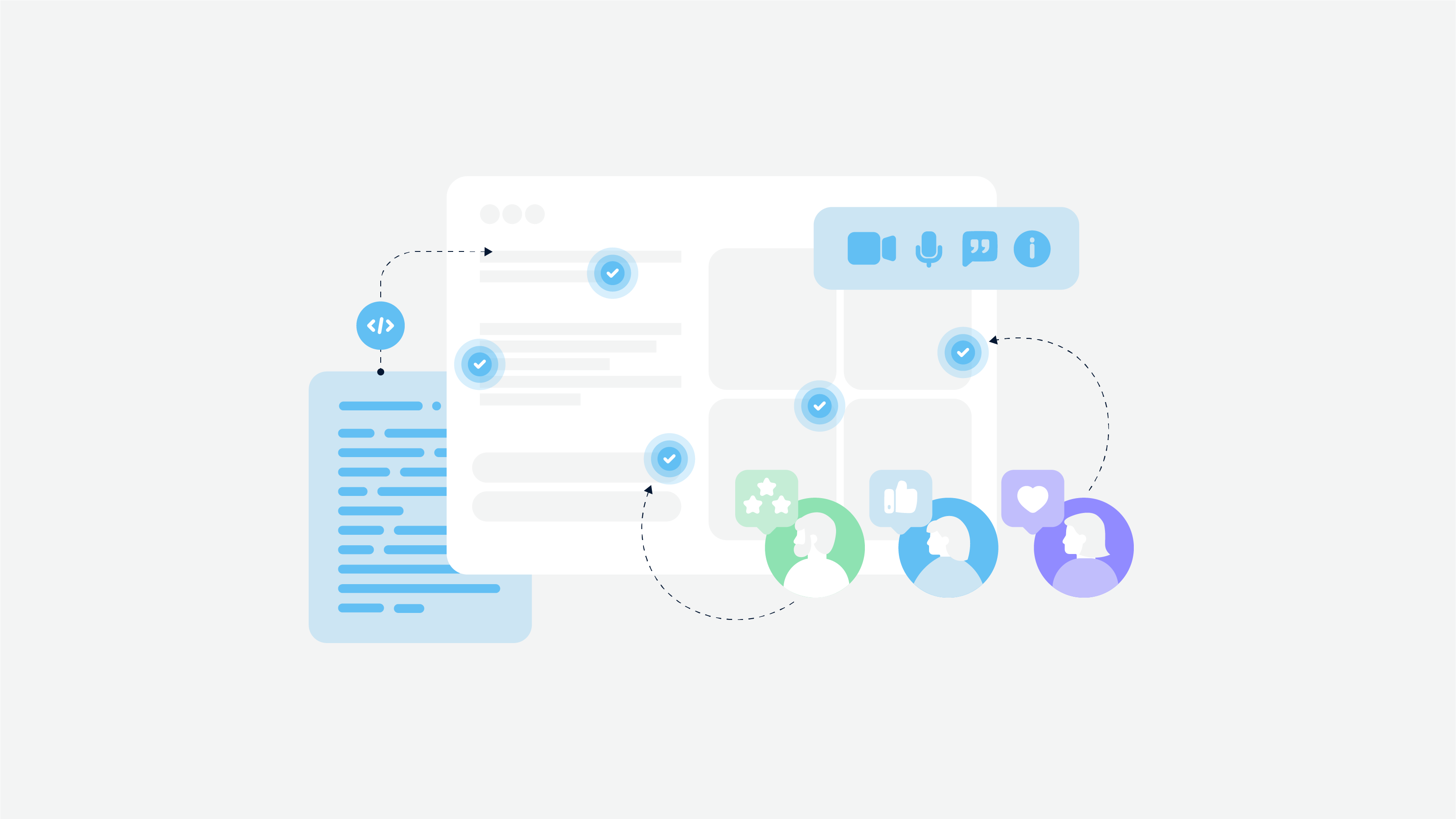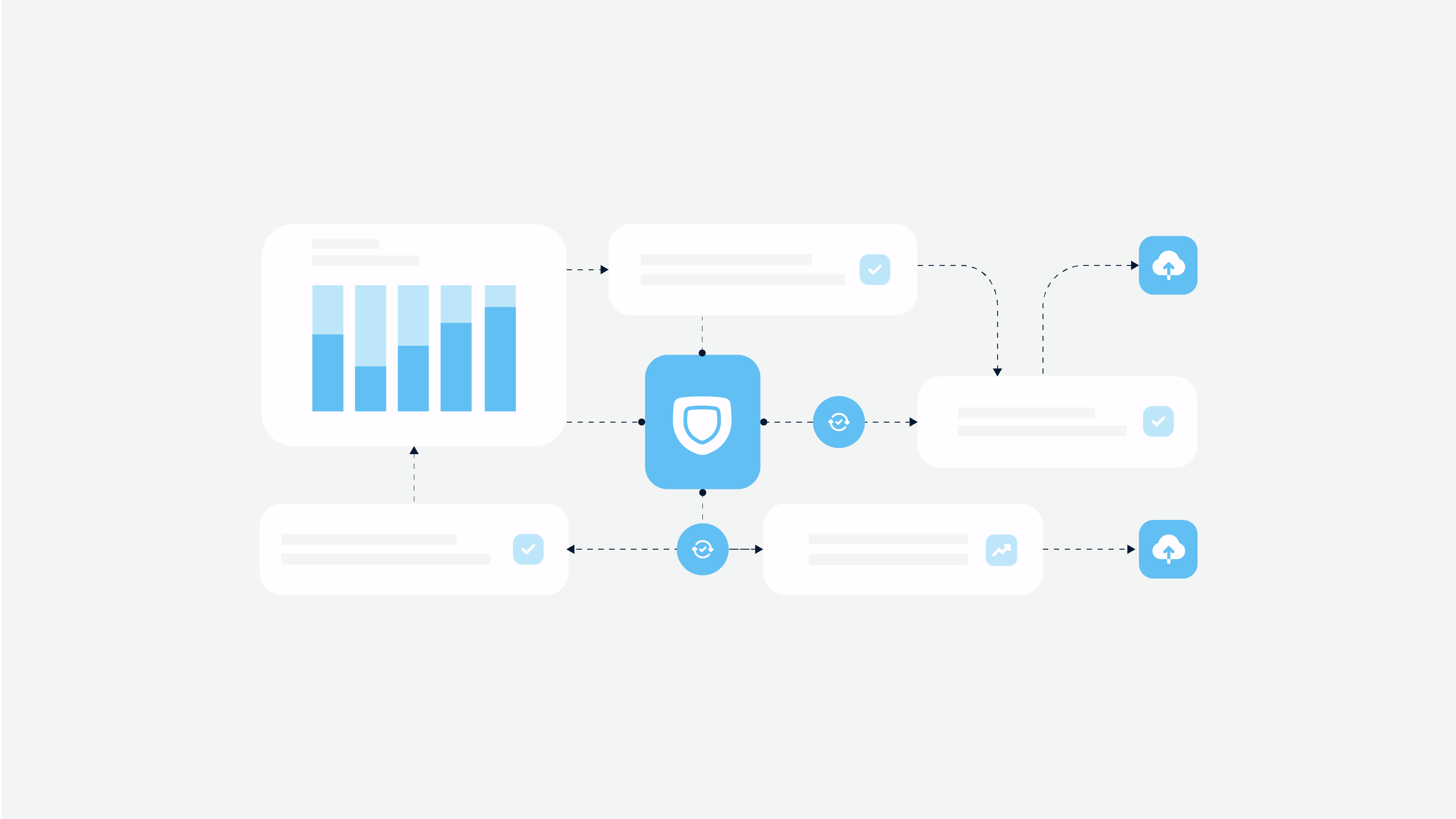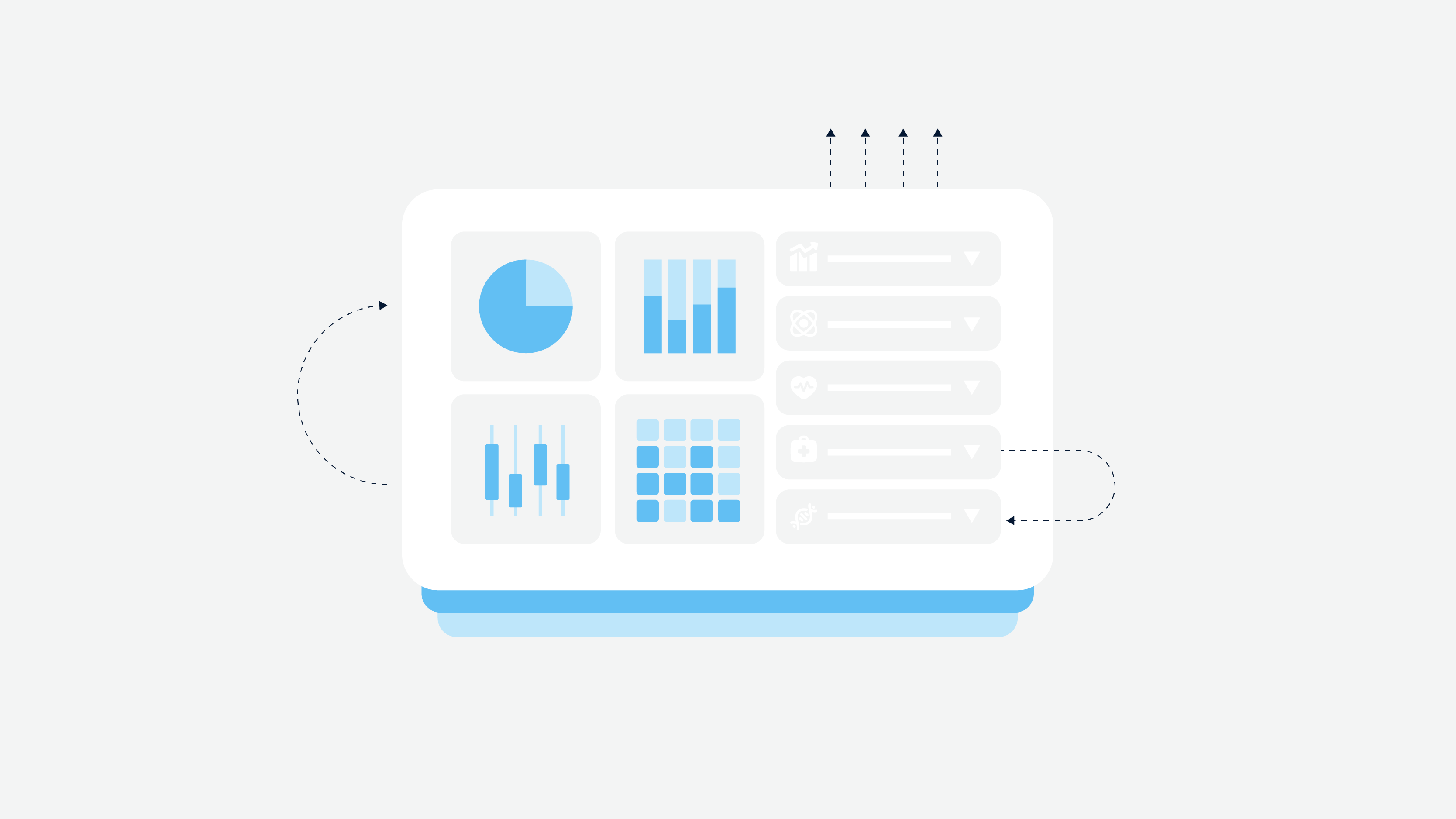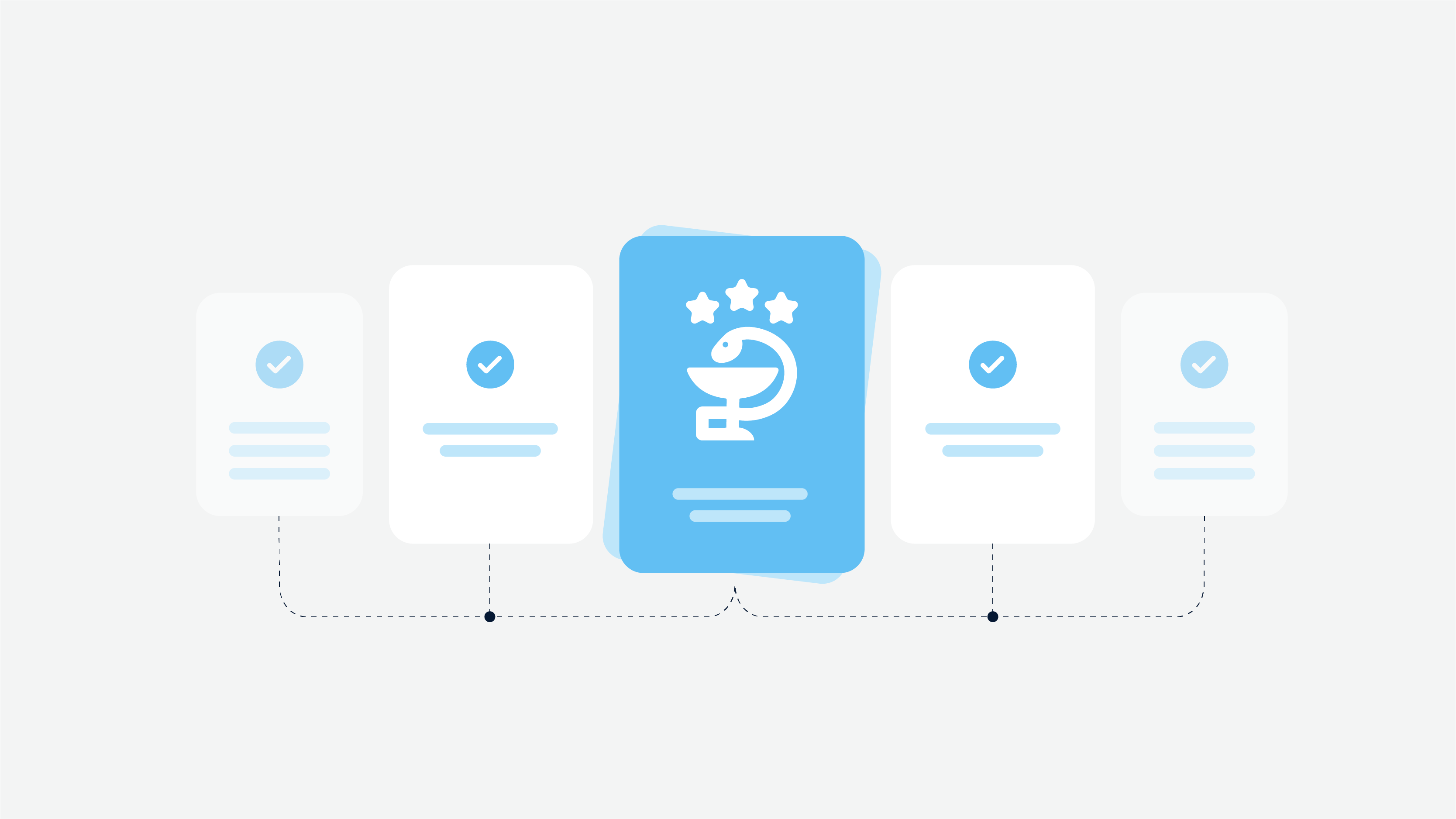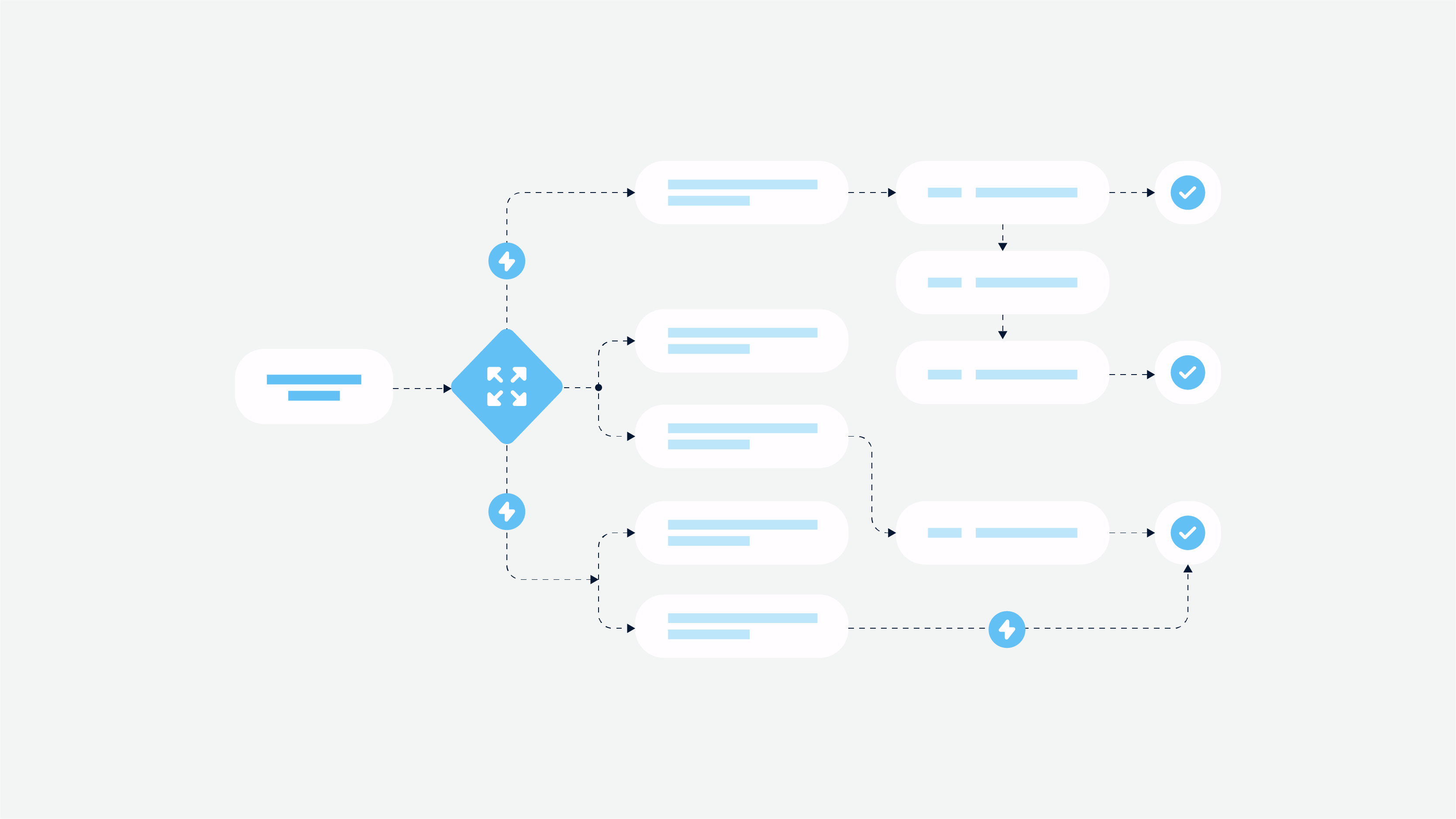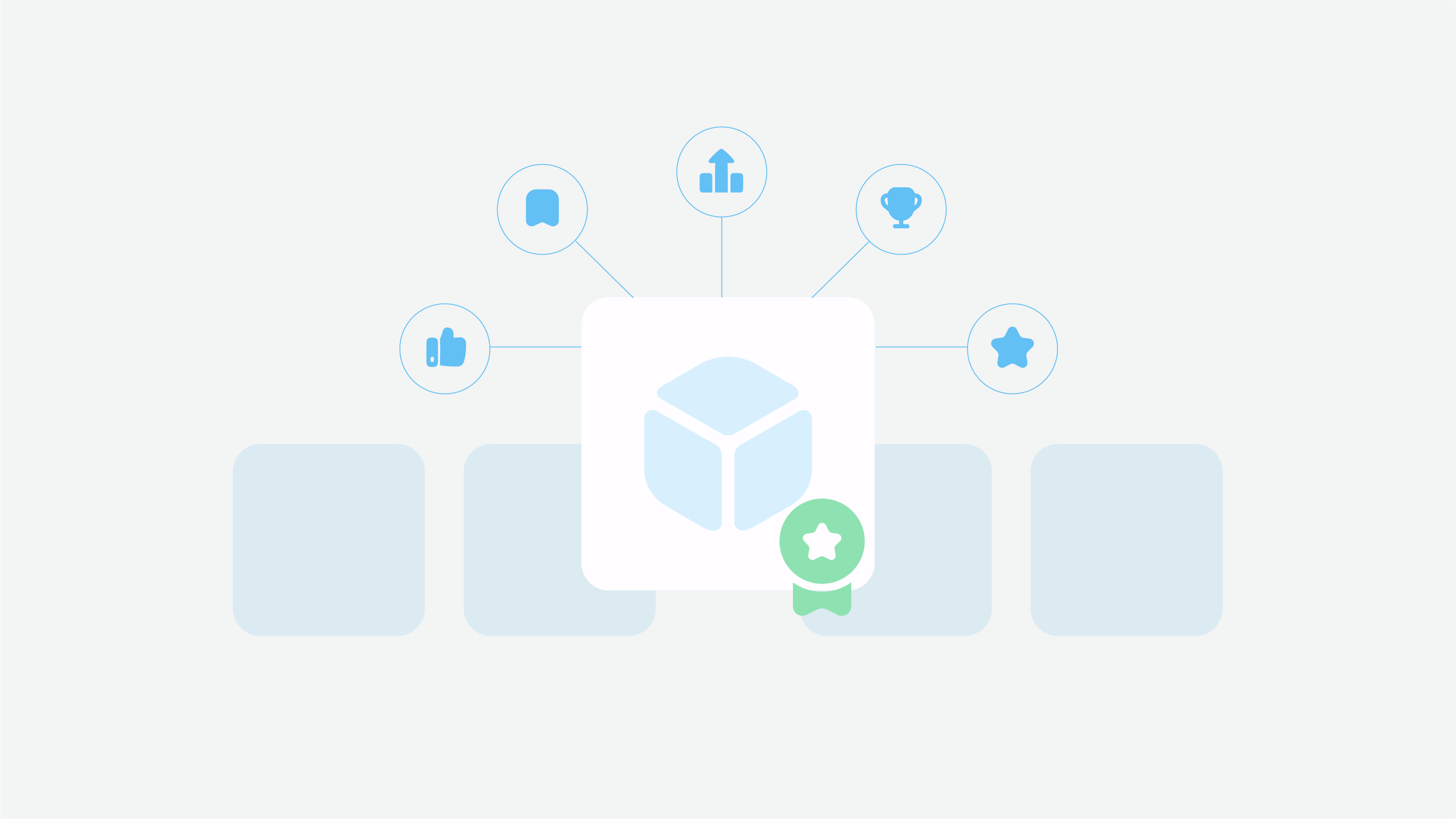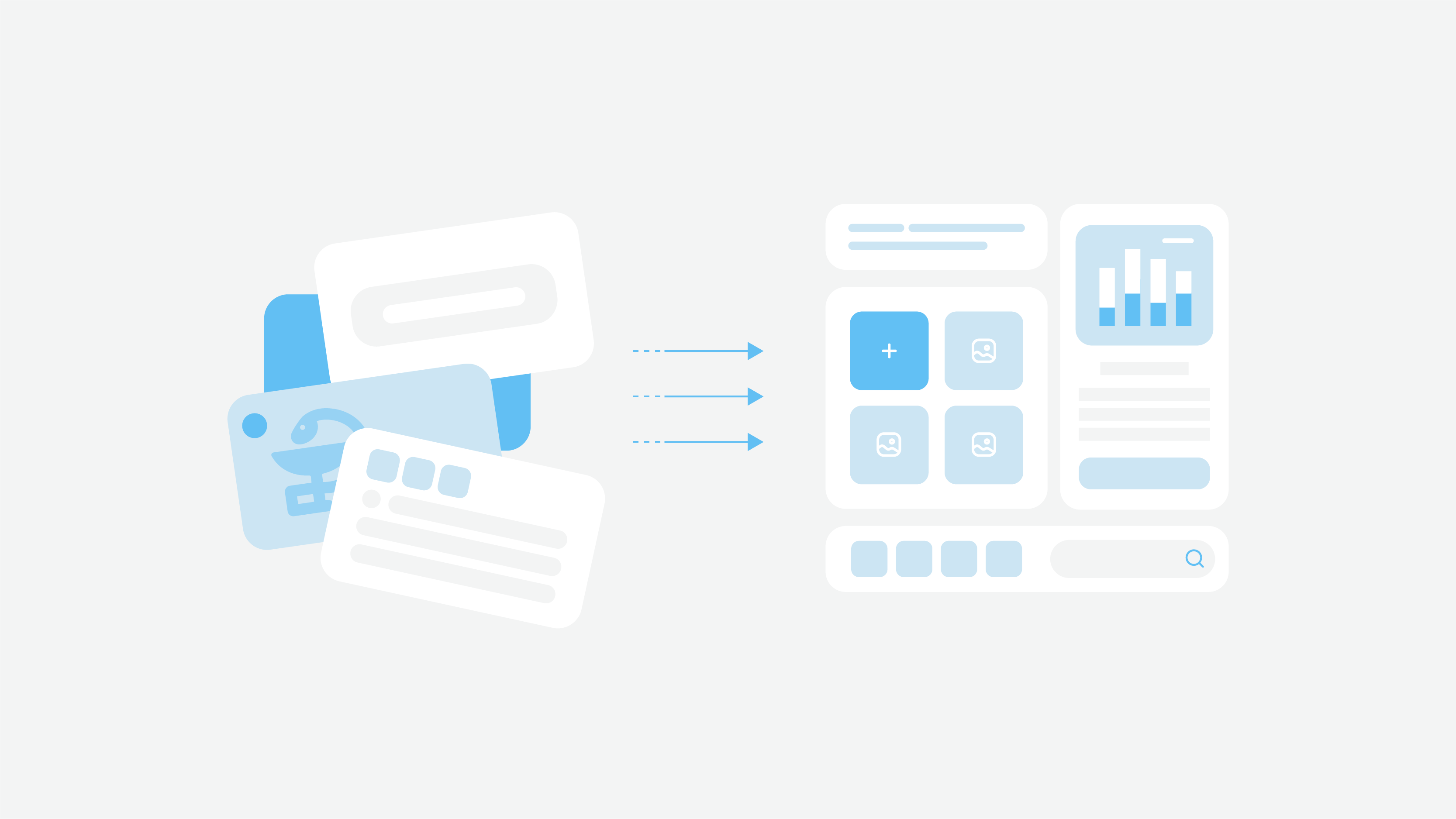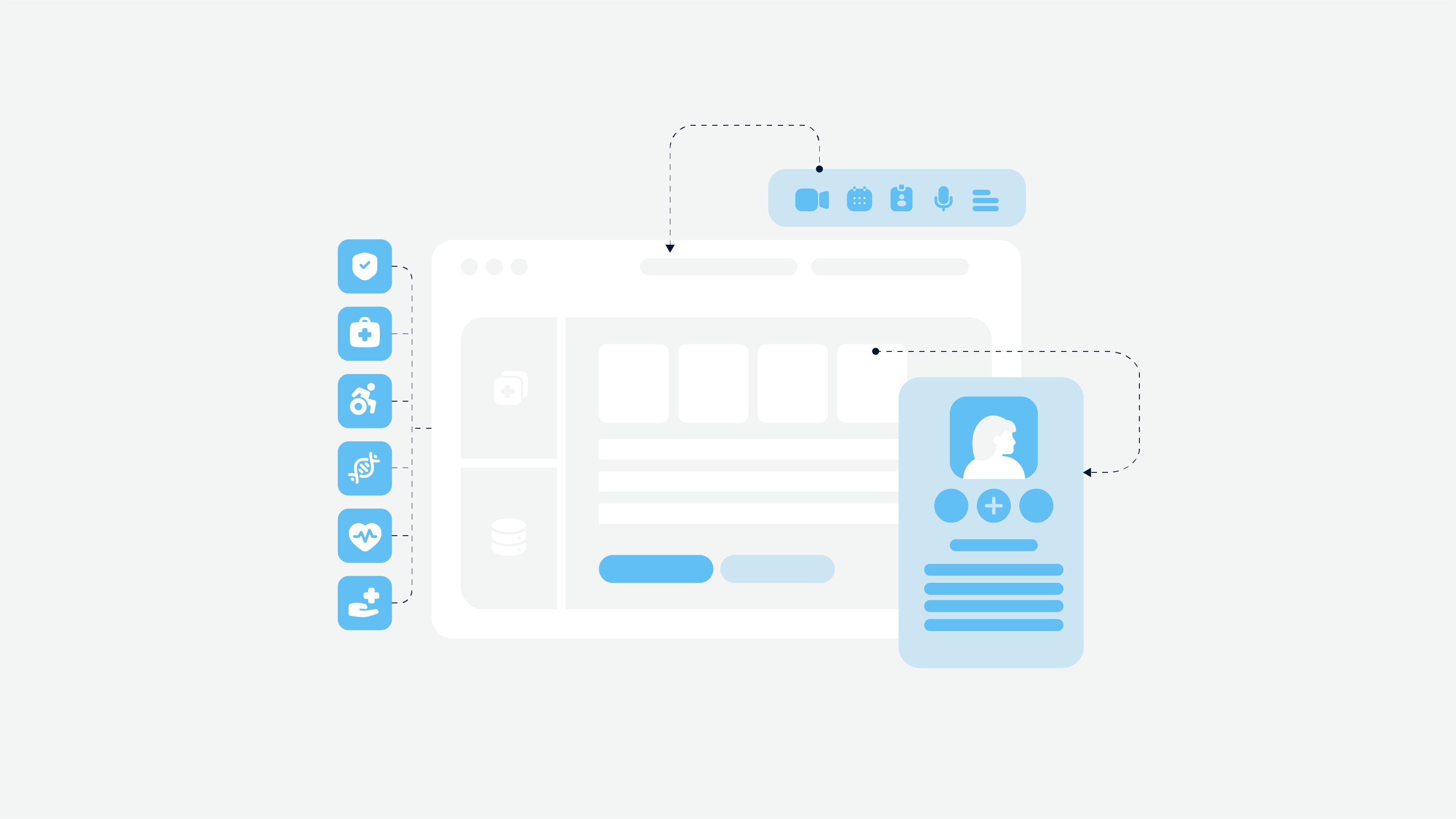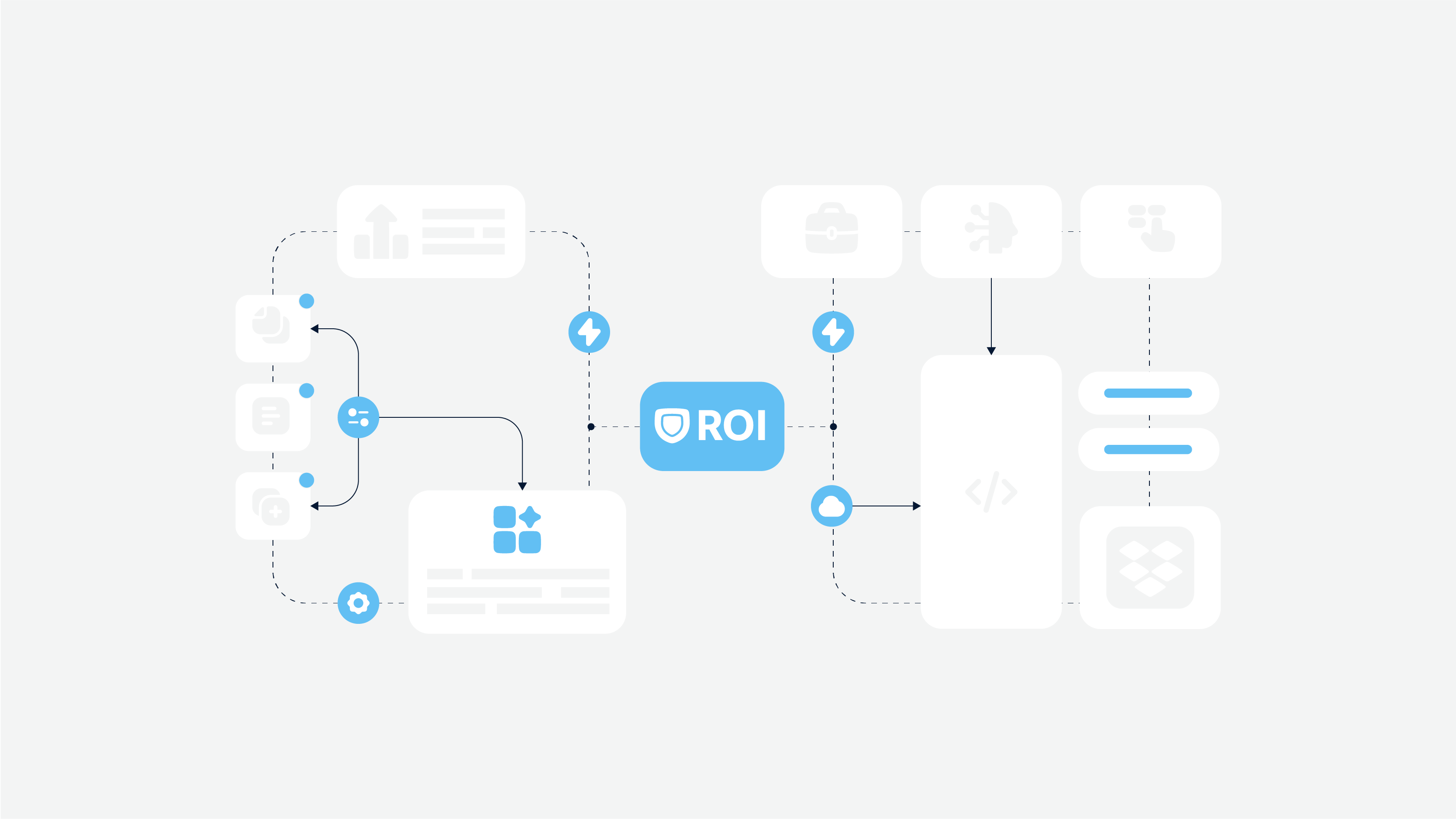Healthcare software is the most important tool of moder medical systems. When done right, it can streamline operations, really improve patient care, and make life a whole lot easier for medical professionals.
But for software to really work, it needs to do more than just function — it needs to feel seamless, intuitive, and easy to use. UX isn’t just about pretty interfaces (don’t get it wrong, they are crucial); it’s about making sure that the software fits the needs of the people using it.
In this guide, we’ll dive into why UX design is crucial in healthcare and how it can make a massive difference in the way we deliver care. From reducing errors to improving communication, get ready to see how thoughtful design can transform healthcare solutions for the better.
What is User Experience Design?
User experience (UX) design is all about crafting products that deliver meaningful and relevant experiences to users. It focuses on the entire journey users take when interacting with a product, ensuring it’s smooth, intuitive, and enjoyable. In healthcare solutions development, UX design makes complex systems user-friendly and efficient.
Importance of User Experience Design in Healthcare
Proper software development isn’t just about writing code. The foundation lies in understanding the unique challenges of the healthcare world. That’s where UX design steps in, bridging the gap between technical solutions and real-world needs.
A well-thought-out UX design can make a world of difference by:
Tailoring software to the needs of healthcare professionals and patients.
Reducing medical errors with intuitive interfaces that leave no room for confusion.
Enhancing patient outcomes by streamlining care delivery.
Improving the overall quality of care with systems that work like a charm.
Whether it is revenue cycle management software or patient portal for healthcare services, good UX design makes software that truly works for people when it matters most.
Need some help with UX design for your application? We are here to assist! Book a free UX consultation with our experts!
Benefits of Healthcare Software Development
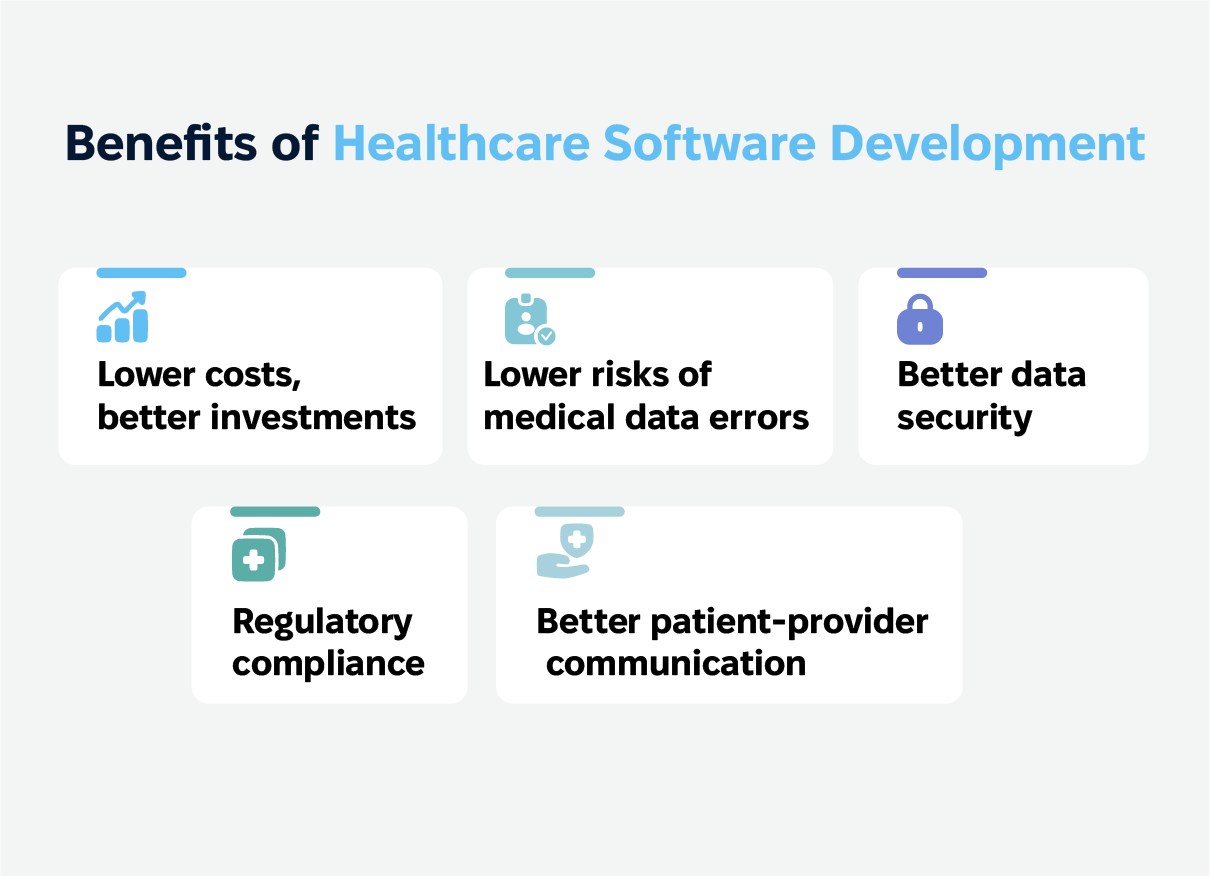
Reducing Costs
Tailored healthcare software significantly reduces costs by streamlining administrative tasks and improving operational efficiency. EHR solutions, for instance, allow healthcare institutions to provide more care while utilizing fewer resources.
Custom healthcare applications can fill all your potential necessities in a single system and optimize resources. Moreover, EHR and telemonitoring reduce the dependency on paper forms as well as the need for active patient participation in order to save money.
Mitigating the Risks of Medical Data Errors
Medical data inaccuracies are not only a consequence of human error but also due to inefficient software systems and a lack of proper security. Custom software applications can be tailored to your unique requirements and minimize the amount of human interference with the data. In addition, encryption and access controls will further protect the data and reduce human errors.
Enhancing Data Security
Encryption and controls like pass-locked keypads are non-negotiable essentials when creating custom software for the healthcare industry. By integrating advanced security measures, custom software can ensure that unauthorized access to sensitive information (including electronic health records) is dead in the water. Without proper permissions, any attempt to breach the system will hit a brick wall, thanks to robust encryption and impenetrable codes.
Improving Patient-Provider Communication
With proper healthcare software development services, you are able to foster clear patient-provider communication through secure and easy channels. Custom software solutions address your organization’s unique communication needs. How? Tools like telemedicine platforms and patient portals make it more accessible, seamless, and patient-centric.
Ensuring Regulatory Compliance
Compliance with regulatory standards such as HIPAA and HITECH is the bread and butter of healthcare application development. Custom solutions can be carefully crafted to meet specific regulatory requirements, so you stay on the right side of the law. Advanced security measures and specific controls for patient records (they are listed in security standards, by the way) not only support compliance efforts but also safeguard patient data and uphold organizational integrity.
Custom Healthcare Software Development Process
Step 1. Identify The Right Problem
The journey starts with finding the right problem to solve. To be honest, this is the most important step as it gives you the right direction on your path. Otherwise, you may waste tons of money and time.
This step requires understanding the healthcare industry’s pain points and opportunities. Find someone who can get to the root of the issue and identify the problems that need to be solved so you don’t waste time chasing ghosts.
Step 2. Define The End Users
Next, it’s essential to define who will be using the software. Here’s where professional UX designers step in.
End users can include healthcare professionals, patients, or administrators. UX researchers and designers perfectly understand their needs, pain points, and expectations to create a product that truly hits the nail on the head.
Step 3. Build A Software Product Development Team
A great team is the base of any successful custom software project. Apart from UX specialists, you’ll need skilled developers and organized project managers who know the ins and outs of the healthcare software development landscape.
How to find them? Well, you can partner with a healthcare software development company. It’ll give you access to pros who have specific expertise and can help keep the process running like a well-oiled machine.
Step 4. Create a Minimum Viable Product (MVP)
The MVP is your first big checkpoint. It’s a simplified version of the software that ticks all the essential boxes for end users. Think of it as dipping your toes in the water to see how it feels before diving in. With an MVP, developers can gather real-world feedback and make tweaks so the final product is a perfect match for users’ needs.
Step 5. Conduct Comprehensive Testing
Testing is where you find out if your software is ready for the real world. This step ensures it’s functional, easy to use, and secure. You’ll want to check usability, performance, and data protection to smooth out any rough edges. A good healthcare development partner will have this down to a science, making sure your product is solid and reliable.
Step 6. Release the Product and Provide Ongoing Maintenance
Once the software clears all tests with flying colors, it’s time to launch! But don’t think of this as the finish line. It’s more like the start of the next phase.
Regular maintenance and updates are key to keeping everything running smoothly and adapting to new needs. A dependable healthcare software partner will stick around to make sure your software stays in top form for the long haul.
Read how we harness all the incredible power of UX design for tailored healthcare software
Trends for Healthcare Software Development in 2025
VR and AR technologies
VR and AR are the stars of the show in healthcare software development. These technologies bring immersive experiences for both patients and healthcare professionals. From medical staff sharpening their skills with virtual training to patient rehabilitation, VR and AR are the future.
The numbers don’t lie: the global healthcare AR and VR market is expected to grow from $3.3bn in 2023 to $19.1bn by 2033.
Internet of Medical Things (IoMT)
The Internet of Medical Things (IoMT) refers to a network of interconnected medical devices and sensors that collect and transmit data in real time. This technology drastically improves patient monitoring and care efficiency.
The IoMT market was valued at $230.69 billion in 2024 and is set to grow by a whopping 18.2% annually from 2025 to 2030.
Blockchain for Data Security
When it comes to keeping patient data safe, blockchain is the go-to choice. Its secure, tamper-proof records make sure data stays intact and confidential. For healthcare organizations, using blockchain means no more losing sleep over breaches or unauthorized access.
The global blockchain technology market in healthcare was valued at $7.04 billion in 2023, and it’s expected to grow at an incredible rate — 63.3% annually — reaching $214.86 billion by 2030. This rapid growth is happening because healthcare needs more secure and transparent data management.
Blockchain’s decentralized and unchangeable ledger ensures the integrity of the data and lowers the risk of breaches, which is critical for managing sensitive patient information. From what we’ve seen, using this tech has made a real difference in data security, giving both healthcare providers and patients peace of mind.
Big Data Analytics
Big data analytics is a total shift in healthcare. It’s like unlocking a treasure chest full of insights that help healthcare providers make smarter decisions and offer better care. Now, you can use huge sets of data to spot patterns and customize treatments to fit each of your patients.
In fact, the global market for big data analytics in healthcare was worth $29.7 billion in 2022 and is expected to reach $134.9 billion by 2032, growing at a strong rate of 16.7% annually. That’s a big jump, and it’s all fueled by the rise of electronic health records (EHR), telehealth, and mobile health apps — all of which rely on cloud tech (and we’ll discuss all these technologies later).
From our experience, using big data analytics helps healthcare providers make decisions that truly improve treatment results and streamline the whole process. It’s an exciting time, as big data is opening up tons of new possibilities to boost the quality of care and innovation in healthcare.
Cloud Transformation
The cloud is reshaping healthcare by offering flexible, scalable solutions that grow with organizational needs. Moving to the cloud means easier data sharing, improved collaboration, and lower operational costs. For healthcare providers, it’s like trading in an old toolbox for a state-of-the-art workshop.
Choosing the Right Healthcare Software Development Companies
Picking the right partner for your healthcare software project is like finding the perfect pair of shoes; it has to fit just right. Here are the key qualities to look for:
Industry knowledge
A great healthcare software development company should know the healthcare world inside and out. They need to understand the unique challenges, compliance requirements, and workflows that make the industry tick. Having this insider knowledge ensures they can design solutions that truly meet the needs of healthcare providers and patients alike.
Technical expertise
Technical expertise and deep knowledge of the tech stack are non-negotiable. The right company will have a strong grasp of programming languages, modern software development practices, and, most importantly, top-notch data security measures. When you work with experts who know the ropes, your project stays on track and delivers exactly what you need.
Scalability and capacity
Healthcare organizations are always growing and evolving, so your software needs to keep up. Look for a company that has the resources (experienced developers, designers, and project managers) to scale up when needed. It’s all about having a partner who can go the extra mile as your needs change.
Security measures
In healthcare, protecting sensitive patient data is the law. A reliable software development company will offer rock-solid security measures like encryption, access controls, and secure storage. These aren’t just bells and whistles; they’re the backbone of any trustworthy healthcare software solution.
The Role of User Experience Design in Healthcare
Some people believe that design is just about making things look pretty. That’s not true, although appearance is a part of the designer’s job. Proper design, and UX in particular, is about making your healthcare software development solutions work well for everyone involved.
In healthcare, this can mean the difference between a smooth patient experience and one that leads to confusion or frustration. Here’s how UX design plays a crucial role.
Designing for Patient Engagement
When it comes to patient engagement, UX design takes center stage. Its task is to create intuitive, user-friendly software that makes it easy for patients to interact with their healthcare providers and manage their care. Custom healthcare software that focuses on UX design can help build patient-centered solutions that keep users engaged and informed.
Statistical Proof: Studies show that user-friendly healthcare platforms lead to higher patient engagement, with 77% of patients saying they prefer to access their health information digitally when it’s easy to use.
Creating User-Friendly Interfaces
In healthcare, the last thing you want is for users, whether patients or healthcare professionals, to feel overwhelmed by complicated software. A great UX design can simplify complex tasks, making software interfaces easier to navigate and reducing the risk of errors. For healthcare professionals, this means more efficient workflows, while for patients, it translates to a smoother experience in managing their health.
Statistical Proof: According to a report, 90% of patients say that an easy-to-navigate app improves their experience and helps them stay on track with their healthcare needs.
Improving Patient Outcomes
When healthcare software is designed with the user in mind, it can improve engagement, reduce medical errors, and make it easier for patients to stick to treatment plans. Ultimately, when focusing on what patients need, custom software can help drive better health outcomes.
The Future of Healthcare Software Development
Self-Care and Patient Portals
Self-care tools and patient portals let patients access their medical records, book appointments, and even get personalized health advice — all from their phones or computers. Basically, you’re giving the patients the keys to their health.
Custom healthcare software that includes self-care tools and portals keeps patients engaged and makes communication with providers much easier. For instance, The PatientView web portal (national education and self-management medical platform) has now been implemented in more than 90% of all renal units in the UK. And 94%of its users found it “very valuable” to have access to their health records from home.
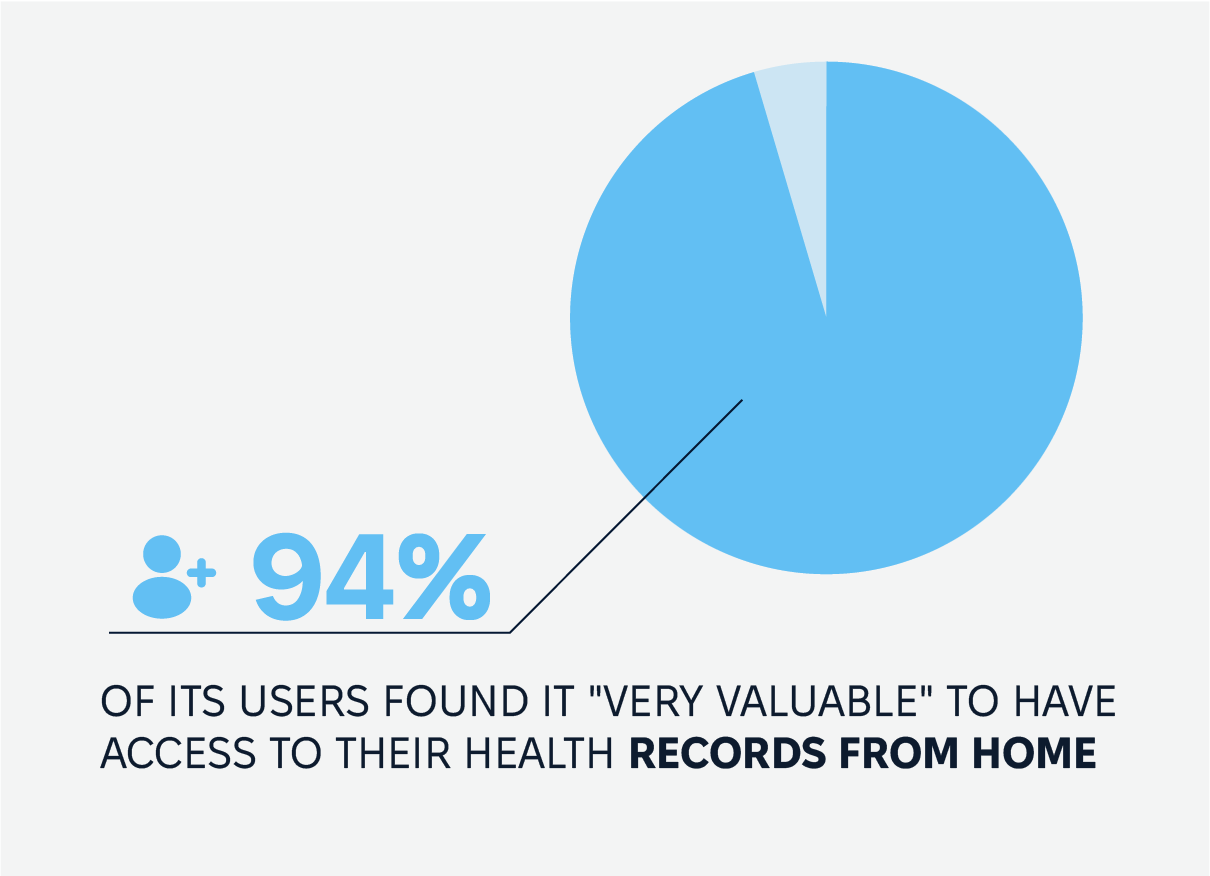
Advanced Electronic Medical Records
From what we’ve seen, integrating Electronic Medical Records (EMRs) really helps healthcare teams work together more smoothly. It makes it easier to provide well-rounded care. When doctors can quickly share test results, connect with specialists, and keep medication records updated, it ties everything together and makes the whole process more reliable for both patients and healthcare providers.
In fact, studies show that using EMRs improves communication between healthcare teams, which leads to better patient outcomes. For example, a study in the Journal of the American Medical Informatics Association found that EMRs helped improve care coordination and reduce errors.
Also, when evidence-based information is included in EMRs, it boosts teamwork and helps clinicians make better decisions faster without getting overwhelmed by too much information. In our experience, the integration of EMRs makes a huge difference. It not only speeds up workflows but also ensures that healthcare teams are on the same page. Whether it’s sharing patient info, collaborating with other specialists, or keeping records up to date, everything works more seamlessly.
Telemedicine
Telemedicine is on the rise, with the market expected to hit $317.59 billion by 2030. It’s changing the game by letting patients connect with healthcare providers remotely, whether it’s a video consultation or remote monitoring. For people who can’t make it to a clinic, telemedicine makes medical care more accessible.
Specialty telemedicine and remote patient monitoring centers are becoming a big deal. These focus on specific areas like mental health, dermatology, or chronic conditions, offering care that’s personalized and easy to access. As telemedicine grows, these specialized services are filling a real need, making healthcare more targeted and effective.
Artificial Intelligence and Machine Learning
We hear about Artificial Intelligence and Machine Learning at every turn, and it’s no surprise. It’s hard to imagine the world without these technologies, especially in the world of medical platforms and innovations.
How does it work in healthcare? Well, first, these technologies analyze large volumes of data quickly and accurately, which pushes the ideal personalized care and gives you access to the most accurate predictive analytics.
Secondly, AI-powered tools can help detect patterns and predict patient outcomes. Why is this so important? Because, in sum, all of this supports decision-making based on real data, making healthcare more proactive and precise.
Imagine AI-powered systems diagnosing conditions early and recommending the best treatment options. This is exactly how AI is dramatically transforming the way we approach patient care.
Cloud Integration for Proper Data Management
Cloud integration is an undeniable trend in any industry, and healthcare is no exception. This is great news because cloud technologies are enabling better collaboration between medical professionals, departments, and organizations. You can’t even imagine how much this simplifies processes like analyzing medical histories, quickly diagnosing conditions, and facilitating communication between specialists for better results.
Moreover, by storing and accessing data securely in the cloud, healthcare teams can share patient information in real-time, regardless of location. You could be treating a patient in one hemisphere while consulting with colleagues from another, and all of this happens immediately.
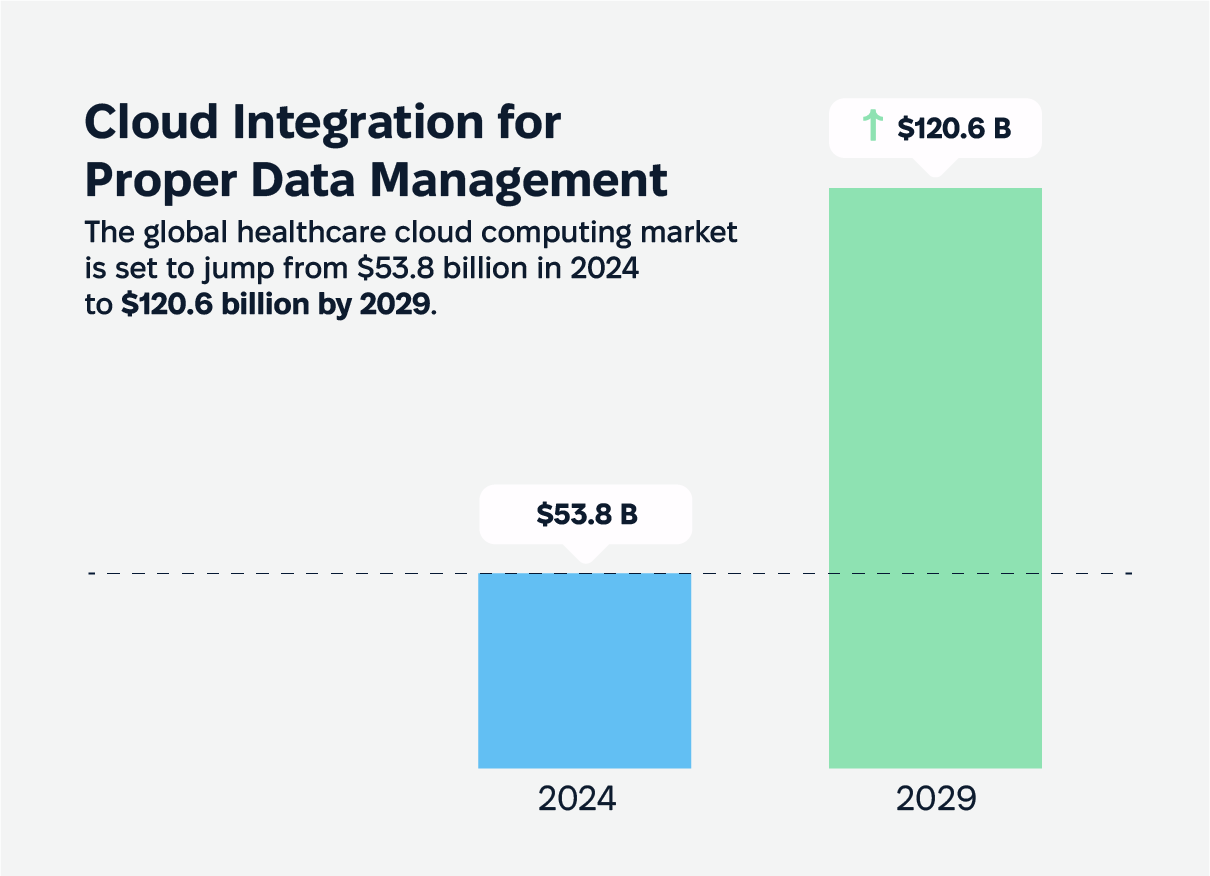
Here are some stats. The global healthcare cloud computing market is set to jump from $53.8 billion in 2024 to $120.6 billion by 2029. This growth is mainly thanks to more use of things like electronic health records (EHR), telehealth, health apps, and wearable tech. Cloud computing makes it easier to store data, scale systems, and save costs, all of which help healthcare move forward. The only roadblocks? Data security concerns and tricky regulations could slow things down a bit.
Best Practices for User Experience Design
Conducting User Research
User research is where great user experience design starts. It’s all about getting to know your users: their needs, struggles, and what makes them tick. If you don’t understand them, you’re basically flying blind. In healthcare software development, user research helps create patient-centered solutions that actually solve real problems, not just look good on paper.
Creating Wireframes and Prototypes
Wireframes and prototypes are like the rough drafts of your design. They’re quick and easy ways to get your ideas down, see what works, and figure out what doesn’t before you’ve invested too much time or money. For healthcare software, this is the chance to get creative and innovative while staying focused on what your users actually need.
Maintaining Consistency Across the Board
Consistency is fundamental when it comes to user experience. In our work, we’ve found that when the layout, navigation, and design language are consistent across the board, users don’t have to waste time figuring out how to use your software. It’s like driving on a familiar road: you always know where you’re going.
While developing healthcare software, think of consistency as a glue. It allows users (doctors, nurses, admin staff, patients) to complete tasks like entering patient data or reviewing test results without missing a beat. This results in fewer errors and creates a smooth, seamless experience every time. An additional perk is better brand awareness.
Testing and Iterating
Here, you can test your ideas, get feedback, make changes, and keep going until it’s just right. This isn’t a one-and-done thing but more like a loop; you keep running until everything clicks. In healthcare, through testing, you’re making something people can rely on. It’s all about getting it right, not just getting it done.
Accessibility in Mind
Accessibility is essential for every product, but in the healthcare sector, it must be at the heart of every application. This is the bread and butter of true care.
From our experience, designing with accessibility in mind guarantees that every client, regardless of ability, can use your software without a hitch. This means thinking about users with visual, hearing, motor, or cognitive challenges. And such an approach brings the most important value — credibility and trust (which results in money, by the way).
Whether it’s a nurse with limited mobility or a patient using assistive technology, your design needs to be inclusive. We’ve seen firsthand how accessible design not only helps people but also strengthens your brand. It’s good for business and good for people.
The Benefits of Custom Solutions for Healthcare Professionals
Tailored Solutions: One Size Can't Fit All
Every business has its challenges and problems to solve, and ready-made software can only partially deal with them. Custom healthcare software provides you with a specific solution that fits your business like a glove.
It’s designed specifically to address unique needs, improve patient outcomes, cut costs, and tackle the challenges of modern healthcare head-on. Software built with your precise needs in mind is like having a toolbelt stocked with everything you need.
Improved Efficiency
Work smarter, not harder. What about streamlining administrative tasks and improving operations? It all frees up valuable time and reduces costly errors. With better tools at your fingertips, you can focus on what really matters, e.i. caring for patients. Custom solutions help healthcare professionals achieve better outcomes without unnecessary effort.
Data Security: Keeping Things Under Lock and Key
Healthcare data is incredibly sensitive, and keeping it secure is non-negotiable (especially from a regulatory compliance point of view). Custom medical software development can provide progressive security features tailored to your needs. Result? The risk of breaches is much lower; you get compliance with regulations like HIPAA and make smart security investments.
Scalability: Growing with You
As your practice grows, so do your needs. Smartly developed medical software is designed to scale alongside your business. It remains a perfect fit no matter how much you expand.
Whether you’re adding new services, hiring more staff, or dealing with higher patient volumes, custom solutions adapt fast to your changing needs. It’s like having a foundation that’s built to support a growing skyscraper. It must be solid, string, and calculated.
Conclusion
From our experience, custom healthcare software development is making a real difference in the industry and healthcare delivery in particular. It’s about creating solutions that are specifically designed for your unique needs, with all your pains and challenges in mind. This leads to much, much better patient care, lower costs, and more efficient workflow. Not mentioning scalability and security, which are no less important.
Looking ahead, the future of healthcare software is full of exciting possibilities. Self-care portals, advanced EMRs, telemedicine, AI, and tools for managing chronic conditions are all on the rise. These technologies are now enabling healthcare providers to deliver more personalized care, and they gonna improve this process in the near future. They also give patients more control over their health.
When it comes to user experience design, the key is keeping things simple, accessible, and intuitive. Conducting user research, creating wireframes and prototypes, and continuous testing are crucial steps. It’s all about building software that makes sense for both the patient and the healthcare team.
If you’re looking to improve your healthcare software, we’re here to help. Let’s work together to make it happen. Contact us!
FAQ
1. What is User Experience (UX) Design in Healthcare?
User experience (UX) design focuses on creating healthcare software that’s intuitive, easy to navigate, and tailored to the needs of healthcare professionals and patients. It ensures that the software enhances the user’s journey, from reducing errors to improving patient outcomes.
2. Why is UX Design Crucial for Healthcare Software?
UX design is crucial in healthcare because it streamlines complex systems, reduces medical errors, and ensures that healthcare professionals can work efficiently while patients can easily access their health information, resulting in better overall care.
3. What Are the Benefits of Custom Healthcare Software Development?
Custom healthcare software helps reduce costs, mitigate risks of medical data errors, enhance data security, improve patient-provider communication, and ensure compliance with regulations like HIPAA, all while streamlining operations and improving patient care.
4. How Does UX Design Improve Patient Engagement in Healthcare?
UX design enhances patient engagement by creating user-friendly interfaces that make it easier for patients to interact with their healthcare providers, access medical records, and manage their treatment plans, ultimately leading to better health outcomes.
5. What are the Key Trends in Healthcare Software Development for 2025?
Key trends in healthcare software development for 2025 include the use of VR and AR for immersive healthcare experiences, IoMT for improved patient monitoring, blockchain for enhanced data security, big data analytics for personalized care, and cloud integration for better data management and collaboration.
6. How Much Does Custom Healthcare Software Development Cost?
The cost of custom healthcare software development varies depending on the complexity of the project, the features required, and the size of the healthcare organization. While custom solutions might have a higher initial investment, they ultimately reduce long-term operational costs by streamlining workflows, improving efficiency, and minimizing errors, making them a cost-effective choice in the long run.

